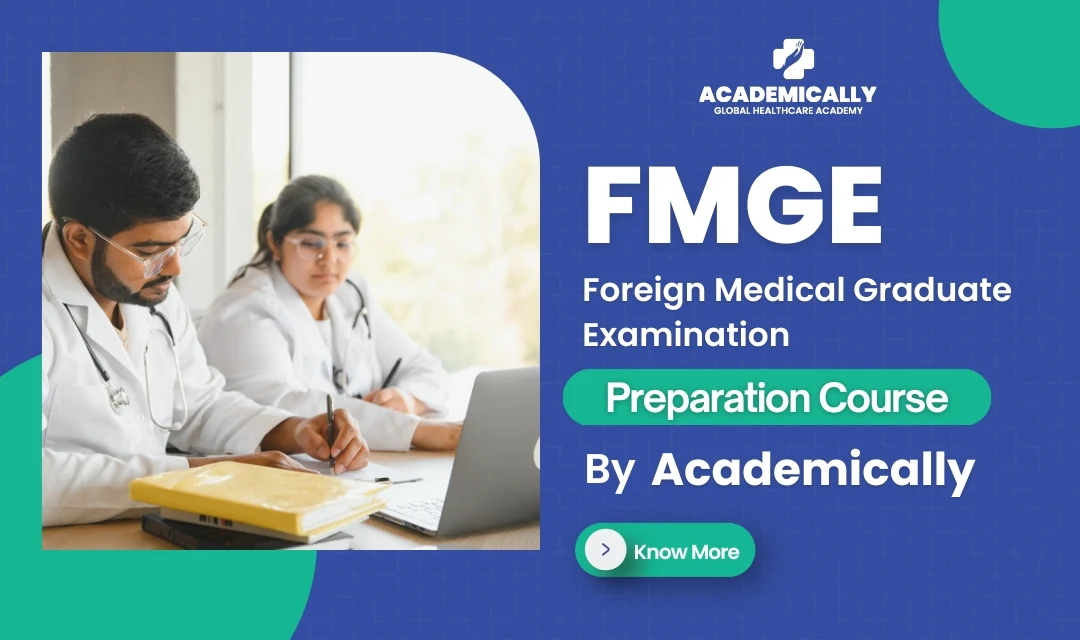The “Top FMGE Exam Questions with Answers” topic is one of the most searched by foreign medical graduates preparing to clear the Foreign Medical Graduate Examination (FMGE).
This licensure exam, conducted by the National Board of Examinations (NBE), ensures that foreign-trained doctors meet India’s professional medical standards. Since the FMGE is known for its difficulty and unpredictable nature, practicing with relevant questions is one of the most effective ways to boost confidence and improve accuracy.
FMGE Overview
| Feature | Details |
| Exam Conducted By | National Board of Examinations (NBE) |
| Exam Mode | Computer-Based Test |
| Total Questions | 300 MCQs (No negative marking) |
| Passing Marks | 150/300 |
| Attempts Allowed | Unlimited |
| Exam Frequency | Twice a year (June & December) |
Top FMGE Exam Questions with Answers
Q. A 27-year-old pregnant female in her first trimester presents to the OPD for a regular antenatal checkup. During blood type screening, potential ABO incompatibility is discussed. The healthcare provider explains that certain antibody types are less concerning than others during pregnancy. ABO incompatibility does not occur due to which antibody in her case?
A. IgA
B. IgG
C. IgD
D. IgM
Correct Answer: IgD
IgD is not involved in hemolysis. ABO incompatibility mainly occurs due to IgM antibodies, while IgG can cross the placenta but is usually less reactive in ABO cases.
Q. An 8-year-old child with a history of GTCS came with an episode of convulsions for more than 45 minutes. What will be the appropriate management for this patient?
A. Lorazepam followed by levetiracetam
B. Valproate followed by gabapentin
C. Carbamazepine followed by lorazepam
D. Levetiracetam followed by valproate
Correct Answer: A. Lorazepam followed by levetiracetam
First-line management of status epilepticus is IV benzodiazepine (lorazepam) followed by a second-line antiepileptic like levetiracetam.
Q. A 6-month-old boy presents with recurrent bacterial and fungal infections, chronic diarrhea, and failure to thrive. He is diagnosed with severe combined immunodeficiency due to an autosomal recessive inheritance pattern. Which enzyme deficiency is responsible?
A. Phosphomannose isomerase
B. Ornithine transcarbamylase
C. Hypoxanthine-guanine phosphoribosyltransferase
D. Adenosine deaminase
Correct Answer: 4
ADA deficiency causes toxic metabolite accumulation → T & B cell dysfunction, leading to classic severe combined immunodeficiency.
Q. A 10-year-old boy is brought to the ED after being stung by a bee while playing outside. Within minutes of the sting, he developed shock, respiratory failure, and vascular collapse. What type of hypersensitivity reaction is most likely responsible?
A. IgG-mediated reaction
B. IgA-mediated hypersensitivity
C. IgE-mediated reaction
D. T cell-mediated response
Correct Answer: C. IgE-mediated reaction
Anaphylaxis is a Type I hypersensitivity, mediated by IgE-triggered mast cell degranulation.
Q. A 32-year-old patient presents with blurred vision, photophobia, and mild ocular pain. Examination reveals aqueous flares and keratic precipitates in the anterior chamber. What is the likely diagnosis?
A. Intermediate uveitis
B. Posterior uveitis
C. Toxoplasma uveitis
D. Iridocyclitis
Correct Answer: Iridocyclitis
These findings indicate anterior uveitis (iridocyclitis), presenting with photophobia, pain, and cells/flare in anterior chamber.
Q. Identify the type of fracture in a patient who sustained a road traffic accident resulting in fractures of both the tibia and fibula.
A. Bumper Fracture
B. Patella sleeve fracture
C. Depressed skull fracture
D. Cervical fracture
Correct Answer: 1
A bumper fracture typically results from motor vehicle accidents, affecting the tibia and fibula simultaneously.
Q. Rukmini is attending the village health nutrition and sanitation program day. How frequently is this conducted?
A. Every month
B. Every week
C. Every 14 days
D. Every 3 months
Correct Answer: A. Every month
The village health nutrition and sanitation program day is conducted once every month at the Anganwadi centre for maternal–child health services.
Q. Arrange the order of the Disaster management cycle:
A. Impact-response-rehabilitation-mitigation
B. Rehabilitation-response-impact-mitigation
C. Response-disaster-rehabilitation-mitigation
D. Impact-mitigation-response-rehabilitation
Correct Answer: A. Impact-response-rehabilitation-mitigation
This is the standard cycle followed from disaster occurrence to long-term preventive planning.
Q. Which type of ion channel is affected by mutations in the CFTR gene?
A. Chloride
B. Sodium
C. Potassium
D. Calcium
Correct Answer: A. Chloride
CFTR is a chloride ion channel, and its defect leads to thick secretions seen in cystic fibrosis.
Q. Which among the following is most radiosensitive?
A. Testis
B. Bone
C. Nerve
D. Muscle
Correct Answer: 1
Testicular germ cells are highly mitotically active, making them the most radiosensitive tissues.
How to Use These FMGE Questions Effectively
To score 150+ with ease:
- Solve 20–40 MCQs every day
- Maintain a mistake notebook
- Revise explanations, not just answers
- Take one mock test every week
- Prioritize high-yield subjects (PSM, Pharma, Pathology, Medicine)
How to Crack FMGE on Your First Attempt?
Join Academically’s FMGE Preparation Course with:
- 19-Subject Complete Video Lectures (both live and recorded available)
- Daily MCQs & Topic Tests
- AI-Based Mock Tests and Performance Tracking
- Live Doubt Clearing
- Updated Study Notes
- Personalised Guidance

Final Thoughts
FMGE may be tough, but with the right approach, especially practicing exam-standard MCQs, you can absolutely clear it. The more questions you solve, the better your accuracy, confidence, and speed become.
Start practicing daily, track your weak areas, and stay consistent.You’re much closer to your FMGE success than you think!
If you have any questions or doubts, you can get in touch with our experts at Academically. They will help you out with everything you need to know.